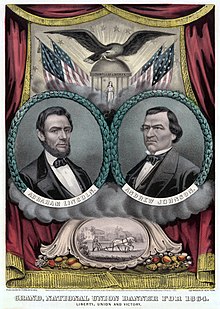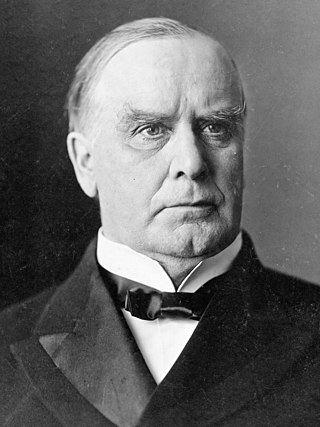
The 1900 United States presidential election was the 29th quadrennial presidential election, held on Tuesday, November 6, 1900. In a re-match of the 1896 race, incumbent Republican President William McKinley defeated his Democratic challenger, William Jennings Bryan. McKinley's victory made him the first president to win a consecutive re-election since Ulysses S. Grant accomplished the same feat in 1872. Until 1956, this would be the last time in which an incumbent Republican president would win re-election after serving a full term in office. This election saw the fifth rematch in presidential history, something that would also not occur again until 1956. This was also the first rematch to produce the same winner both times.
Electoral fusion is an arrangement where two or more political parties on a ballot list the same candidate, pooling the votes for that candidate. It is distinct from the process of electoral alliances in that the political parties remain separately listed on the ballot. The practice of electoral fusion in jurisdictions where it exists allows minor parties to influence election results and policy by offering to endorse or nominate a major party's candidate.
A running mate is a person running together with another person on a joint ticket during an election. The term is most often used in reference to the person in the subordinate position but can also properly be used when referring to both candidates, such as by saying Joe Biden and Kamala Harris, and Uhuru Kenyatta and William Ruto, were running mates in relation to the presidential elections held in the United States in 2020 and Kenya in 2013 respectively.

The 2006 New York gubernatorial election took place on November 7, 2006, to elect the governor and lieutenant governor of New York, concurrently with elections to the United States Senate in other states and elections to the United States House of Representatives and various state and local elections, then incumbent Republican governor George Pataki chose not to run for re-election in a fourth term. Democrat Eliot Spitzer, the New York Attorney General, won the election over former Republican state Assembly minority leader John Faso. As of 2023, this is the last time the Governor’s office in New York changed partisan control.
In United States politics, balancing the ticket is a practice where a political candidate chooses a running mate, usually of the same party, with the goal of bringing more widespread appeal to the campaign. The term is most prominently used to describe the selection of the U.S. Vice Presidential candidate.
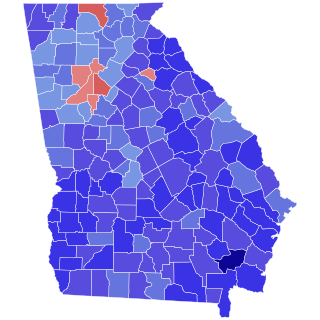
The 1970 Georgia gubernatorial election was held on November 3, 1970. It was marked by the election as Governor of Georgia of the relatively little-known former state senator Jimmy Carter after a hard battle in the Democratic primary. This election is famous because Carter, who was often regarded as one of the New South Governors, later ran for president in 1976 on his gubernatorial record and won. As of 2023, this was the last time Fulton County was carried by the Republican candidate in a gubernatorial election, the only time it failed to back Carter, and the last time a Democrat in any race won without carrying it.

The 2008 United States presidential election in Missouri was held on November 4, 2008, and was part of the 2008 United States presidential election, which took place throughout all 50 states and D.C. Voters chose 11 representatives, or electors to the Electoral College, who voted for president and vice president.

The 2008 United States presidential election in Wisconsin took place on November 4, 2008, as part of the 2008 United States presidential election in which all 50 states plus the District of Columbia participated. State voters chose 10 electors to represent them in the Electoral College via a popular vote pitting Democratic U.S. Senator from Illinois Barack Obama, and his running mate U.S. Senator from Delaware Joe Biden, against Republican challenger and U.S. Senator from Arizona John McCain and his running mate, Alaska Governor Sarah Palin.

The 2008 United States presidential election in North Dakota took place on November 4, 2008, and was part of the 2008 United States presidential election. Voters chose three representatives, or electors to the Electoral College, who voted for president and vice president.

The 2008 United States presidential election in Montana took place on November 4, 2008, and was part of the 2008 United States presidential election. Voters chose three representatives, or electors to the Electoral College, who voted for president and vice president.
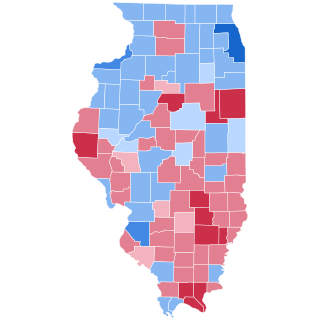
The 2008 United States presidential election in Illinois took place on November 4, 2008, and was part of the 2008 United States presidential election. Voters chose 21 representatives, or electors to the Electoral College, who voted for president and vice president.

The 2008 United States presidential election in Virginia took place on November 4, 2008, which was part of the 2008 United States presidential election. Voters chose 13 representatives, or electors to the Electoral College, who voted for president and vice president.

The 2008 United States presidential election in Alabama took place on November 4, 2008, and was part of the 2008 United States presidential election. Voters chose nine representatives, or electors, to the Electoral College, who voted for president and vice president.
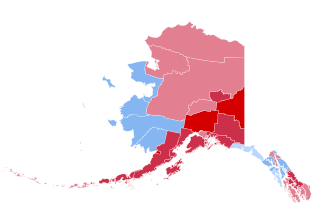
The 2008 United States presidential election in Alaska took place on November 4, 2008, as part of the nationwide presidential election held throughout all 50 states and the District of Columbia. Voters chose 3 electors, or representatives to the Electoral College, who voted for president and vice president.

The 2008 United States presidential election in West Virginia took place on November 4, 2008, and was part of the 2008 United States presidential election. Voters chose 5 representatives, or electors to the Electoral College, who voted for president and vice president.

The 2008 United States presidential election in Florida took place on November 4, 2008, and was part of the 2008 United States presidential election. Voters chose 27 representatives, or electors to the Electoral College, who voted for president and vice president.
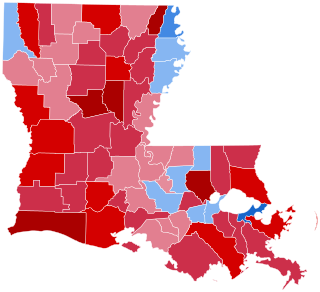
The 2008 United States presidential election in Louisiana took place on November 4, 2008, was part of the 2008 United States presidential election. Voters chose nine representatives, or electors to the Electoral College, who voted for president and vice president.
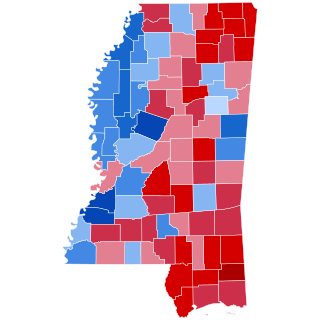
The 2008 United States presidential election in Mississippi took place on November 4, 2008, and was part of the 2008 United States presidential election. Voters chose 6 representatives, or electors to the Electoral College, who voted for president and vice president.

The 2010 Guam gubernatorial election was held on November 2, 2010. Republican Governor Felix P. Camacho was term-limited in 2010 and ineligible to run for re-election. In January 2009, the website D.C.'s Political Report predicted that the Republican Party would retain the governorship. Republican Eddie Calvo won the election.

The 1986 Illinois gubernatorial election was held on November 4, 1986. Republican candidate James R. Thompson won a fourth term in office, defeating the Illinois Solidarity Party nominee, former United States Senator Adlai Stevenson III, by around 400,000 votes.
